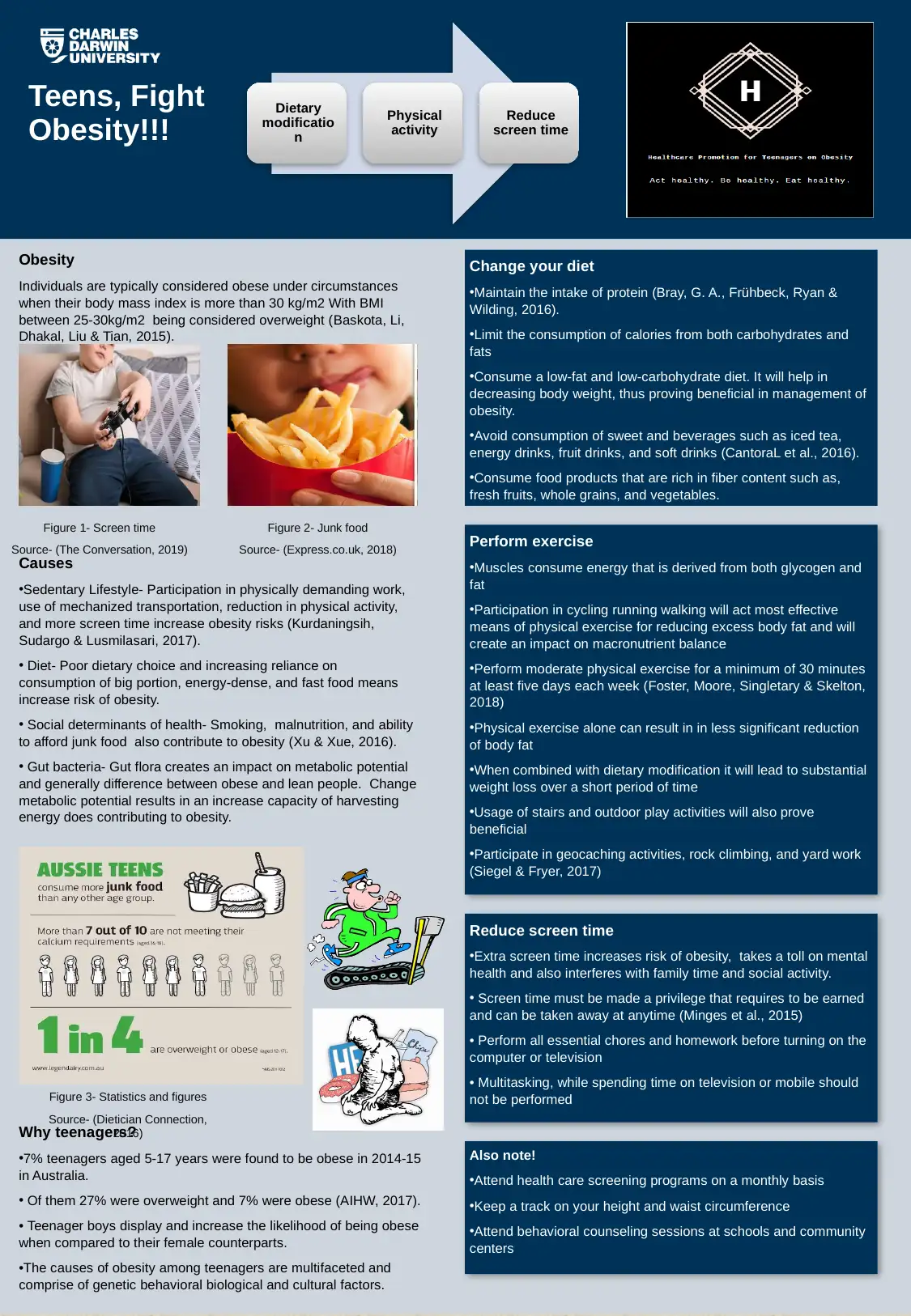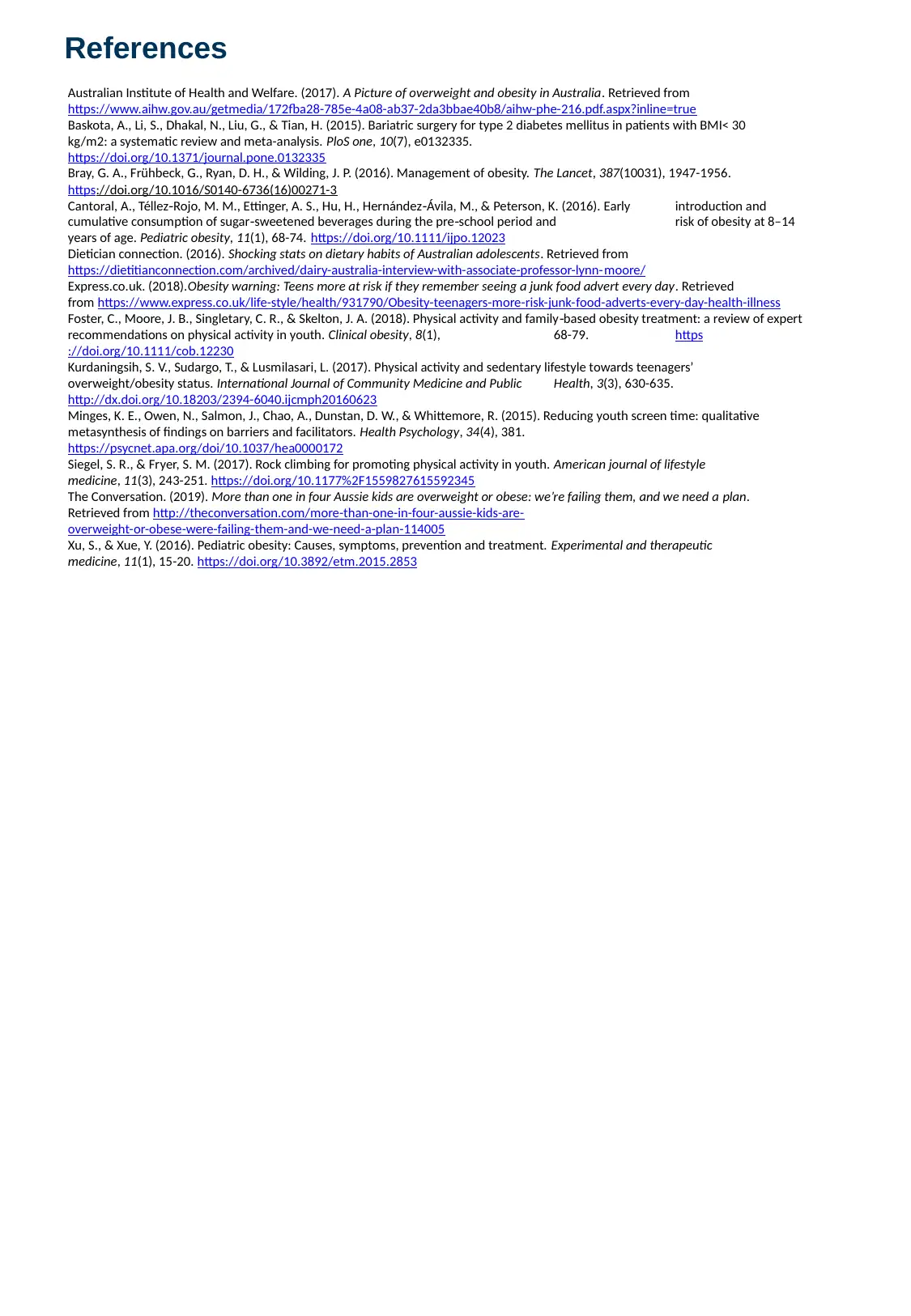Teens, Fight Obesity!!!
VerifiedAdded on 2022/12/12
|2
|1270
|352
Presentation
AI Summary
This presentation discusses the causes of obesity among teenagers and provides strategies to combat it. It covers topics such as dietary modifications, physical activity, and reducing screen time. The presentation also highlights the importance of maintaining a healthy diet, engaging in regular exercise, and limiting screen time to prevent and manage obesity.
Contribute Materials
Your contribution can guide someone’s learning journey. Share your
documents today.

Teens, Fight
Obesity!!!
Obesity
Individuals are typically considered obese under circumstances
when their body mass index is more than 30 kg/m2 With BMI
between 25-30kg/m2 being considered overweight (Baskota, Li,
Dhakal, Liu & Tian, 2015).
Change your diet
•Maintain the intake of protein (Bray, G. A., Frühbeck, Ryan &
Wilding, 2016).
•Limit the consumption of calories from both carbohydrates and
fats
•Consume a low-fat and low-carbohydrate diet. It will help in
decreasing body weight, thus proving beneficial in management of
obesity.
•Avoid consumption of sweet and beverages such as iced tea,
energy drinks, fruit drinks, and soft drinks (CantoraL et al., 2016).
•Consume food products that are rich in fiber content such as,
fresh fruits, whole grains, and vegetables.
Perform exercise
•Muscles consume energy that is derived from both glycogen and
fat
•Participation in cycling running walking will act most effective
means of physical exercise for reducing excess body fat and will
create an impact on macronutrient balance
•Perform moderate physical exercise for a minimum of 30 minutes
at least five days each week (Foster, Moore, Singletary & Skelton,
2018)
•Physical exercise alone can result in in less significant reduction
of body fat
•When combined with dietary modification it will lead to substantial
weight loss over a short period of time
•Usage of stairs and outdoor play activities will also prove
beneficial
•Participate in geocaching activities, rock climbing, and yard work
(Siegel & Fryer, 2017)
Causes
•Sedentary Lifestyle- Participation in physically demanding work,
use of mechanized transportation, reduction in physical activity,
and more screen time increase obesity risks (Kurdaningsih,
Sudargo & Lusmilasari, 2017).
• Diet- Poor dietary choice and increasing reliance on
consumption of big portion, energy-dense, and fast food means
Obesity!!!
Obesity
Individuals are typically considered obese under circumstances
when their body mass index is more than 30 kg/m2 With BMI
between 25-30kg/m2 being considered overweight (Baskota, Li,
Dhakal, Liu & Tian, 2015).
Change your diet
•Maintain the intake of protein (Bray, G. A., Frühbeck, Ryan &
Wilding, 2016).
•Limit the consumption of calories from both carbohydrates and
fats
•Consume a low-fat and low-carbohydrate diet. It will help in
decreasing body weight, thus proving beneficial in management of
obesity.
•Avoid consumption of sweet and beverages such as iced tea,
energy drinks, fruit drinks, and soft drinks (CantoraL et al., 2016).
•Consume food products that are rich in fiber content such as,
fresh fruits, whole grains, and vegetables.
Perform exercise
•Muscles consume energy that is derived from both glycogen and
fat
•Participation in cycling running walking will act most effective
means of physical exercise for reducing excess body fat and will
create an impact on macronutrient balance
•Perform moderate physical exercise for a minimum of 30 minutes
at least five days each week (Foster, Moore, Singletary & Skelton,
2018)
•Physical exercise alone can result in in less significant reduction
of body fat
•When combined with dietary modification it will lead to substantial
weight loss over a short period of time
•Usage of stairs and outdoor play activities will also prove
beneficial
•Participate in geocaching activities, rock climbing, and yard work
(Siegel & Fryer, 2017)
Causes
•Sedentary Lifestyle- Participation in physically demanding work,
use of mechanized transportation, reduction in physical activity,
and more screen time increase obesity risks (Kurdaningsih,
Sudargo & Lusmilasari, 2017).
• Diet- Poor dietary choice and increasing reliance on
consumption of big portion, energy-dense, and fast food means
Secure Best Marks with AI Grader
Need help grading? Try our AI Grader for instant feedback on your assignments.

Teens, Fight
Obesity!!!
References
Australian Institute of Health and Welfare. (2017). A Picture of overweight and obesity in Australia. Retrieved from
https://www.aihw.gov.au/getmedia/172fba28-785e-4a08-ab37-2da3bbae40b8/aihw-phe-216.pdf.aspx?inline=true
Baskota, A., Li, S., Dhakal, N., Liu, G., & Tian, H. (2015). Bariatric surgery for type 2 diabetes mellitus in patients with BMI< 30
kg/m2: a systematic review and meta-analysis. PloS one, 10(7), e0132335.
https://doi.org/10.1371/journal.pone.0132335
Bray, G. A., Frühbeck, G., Ryan, D. H., & Wilding, J. P. (2016). Management of obesity. The Lancet, 387(10031), 1947-1956.
https://doi.org/10.1016/S0140-6736(16)00271-3
Cantoral, A., Téllez Rojo, M. M., Ettinger, A. S., Hu, H., Hernández Ávila, M., & Peterson, K. (2016). Early‐ ‐ introduction and
cumulative consumption of sugar sweetened beverages during the pre school period and‐ ‐ risk of obesity at 8–14
years of age. Pediatric obesity, 11(1), 68-74. https://doi.org/10.1111/ijpo.12023
Dietician connection. (2016). Shocking stats on dietary habits of Australian adolescents. Retrieved from
https://dietitianconnection.com/archived/dairy-australia-interview-with-associate-professor-lynn-moore/
Express.co.uk. (2018).Obesity warning: Teens more at risk if they remember seeing a junk food advert every day. Retrieved
from https://www.express.co.uk/life-style/health/931790/Obesity-teenagers-more-risk-junk-food-adverts-every-day-health-illness
Foster, C., Moore, J. B., Singletary, C. R., & Skelton, J. A. (2018). Physical activity and family based obesity treatment: a review of expert‐
recommendations on physical activity in youth. Clinical obesity, 8(1), 68-79. https
://doi.org/10.1111/cob.12230
Kurdaningsih, S. V., Sudargo, T., & Lusmilasari, L. (2017). Physical activity and sedentary lifestyle towards teenagers’
overweight/obesity status. International Journal of Community Medicine and Public Health, 3(3), 630-635.
http://dx.doi.org/10.18203/2394-6040.ijcmph20160623
Minges, K. E., Owen, N., Salmon, J., Chao, A., Dunstan, D. W., & Whittemore, R. (2015). Reducing youth screen time: qualitative
metasynthesis of findings on barriers and facilitators. Health Psychology, 34(4), 381.
https://psycnet.apa.org/doi/10.1037/hea0000172
Siegel, S. R., & Fryer, S. M. (2017). Rock climbing for promoting physical activity in youth. American journal of lifestyle
medicine, 11(3), 243-251. https://doi.org/10.1177%2F1559827615592345
The Conversation. (2019). More than one in four Aussie kids are overweight or obese: we’re failing them, and we need a plan.
Retrieved from http://theconversation.com/more-than-one-in-four-aussie-kids-are-
overweight-or-obese-were-failing-them-and-we-need-a-plan-114005
Xu, S., & Xue, Y. (2016). Pediatric obesity: Causes, symptoms, prevention and treatment. Experimental and therapeutic
medicine, 11(1), 15-20. https://doi.org/10.3892/etm.2015.2853
Obesity!!!
References
Australian Institute of Health and Welfare. (2017). A Picture of overweight and obesity in Australia. Retrieved from
https://www.aihw.gov.au/getmedia/172fba28-785e-4a08-ab37-2da3bbae40b8/aihw-phe-216.pdf.aspx?inline=true
Baskota, A., Li, S., Dhakal, N., Liu, G., & Tian, H. (2015). Bariatric surgery for type 2 diabetes mellitus in patients with BMI< 30
kg/m2: a systematic review and meta-analysis. PloS one, 10(7), e0132335.
https://doi.org/10.1371/journal.pone.0132335
Bray, G. A., Frühbeck, G., Ryan, D. H., & Wilding, J. P. (2016). Management of obesity. The Lancet, 387(10031), 1947-1956.
https://doi.org/10.1016/S0140-6736(16)00271-3
Cantoral, A., Téllez Rojo, M. M., Ettinger, A. S., Hu, H., Hernández Ávila, M., & Peterson, K. (2016). Early‐ ‐ introduction and
cumulative consumption of sugar sweetened beverages during the pre school period and‐ ‐ risk of obesity at 8–14
years of age. Pediatric obesity, 11(1), 68-74. https://doi.org/10.1111/ijpo.12023
Dietician connection. (2016). Shocking stats on dietary habits of Australian adolescents. Retrieved from
https://dietitianconnection.com/archived/dairy-australia-interview-with-associate-professor-lynn-moore/
Express.co.uk. (2018).Obesity warning: Teens more at risk if they remember seeing a junk food advert every day. Retrieved
from https://www.express.co.uk/life-style/health/931790/Obesity-teenagers-more-risk-junk-food-adverts-every-day-health-illness
Foster, C., Moore, J. B., Singletary, C. R., & Skelton, J. A. (2018). Physical activity and family based obesity treatment: a review of expert‐
recommendations on physical activity in youth. Clinical obesity, 8(1), 68-79. https
://doi.org/10.1111/cob.12230
Kurdaningsih, S. V., Sudargo, T., & Lusmilasari, L. (2017). Physical activity and sedentary lifestyle towards teenagers’
overweight/obesity status. International Journal of Community Medicine and Public Health, 3(3), 630-635.
http://dx.doi.org/10.18203/2394-6040.ijcmph20160623
Minges, K. E., Owen, N., Salmon, J., Chao, A., Dunstan, D. W., & Whittemore, R. (2015). Reducing youth screen time: qualitative
metasynthesis of findings on barriers and facilitators. Health Psychology, 34(4), 381.
https://psycnet.apa.org/doi/10.1037/hea0000172
Siegel, S. R., & Fryer, S. M. (2017). Rock climbing for promoting physical activity in youth. American journal of lifestyle
medicine, 11(3), 243-251. https://doi.org/10.1177%2F1559827615592345
The Conversation. (2019). More than one in four Aussie kids are overweight or obese: we’re failing them, and we need a plan.
Retrieved from http://theconversation.com/more-than-one-in-four-aussie-kids-are-
overweight-or-obese-were-failing-them-and-we-need-a-plan-114005
Xu, S., & Xue, Y. (2016). Pediatric obesity: Causes, symptoms, prevention and treatment. Experimental and therapeutic
medicine, 11(1), 15-20. https://doi.org/10.3892/etm.2015.2853
1 out of 2
Your All-in-One AI-Powered Toolkit for Academic Success.
+13062052269
info@desklib.com
Available 24*7 on WhatsApp / Email
![[object Object]](/_next/static/media/star-bottom.7253800d.svg)
Unlock your academic potential
© 2024 | Zucol Services PVT LTD | All rights reserved.